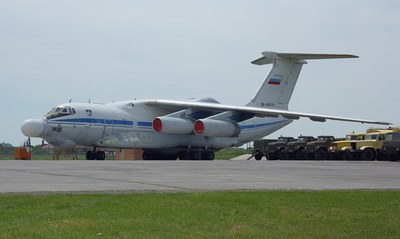
Hubble in the crosshairsby Dwayne A. Day
|
| The aircraft, which is designated the Beriev A-60, is an awkward-looking bird featuring a bulbous nose and several other large bulges to the fuselage. |
The Russians had an active laser weapon development program, as did the United States. What surprised the analysts was that they were unaware of any American “spy balloons” for the Soviets to shoot at. It is possible that the information was compartmented and they didn’t have the need to know about it. The US had certainly flown reconnaissance balloons over the Soviet Union in the 1950s and apparently had a program to disguise signals intelligence receivers as weather balloon equipment during the 1960s. But the émigré’s story did not make sense.
A few years later, the CIA, checking periodic imagery of the airfield where the aircraft was based, saw that it had burned up. Analysts reviewing the evidence concluded that there had probably been an accident involving the reactive chemicals used in the gas-dynamic laser. It would be many years before they learned the truth. A second aircraft was converted, but it was not finished until the early 1990s and was placed in storage without starting test flights.
Jump to the present day. Right now there is an aircraft in Russia that is being flight tested with a laser onboard. Painted on the side of the aircraft are the words “SOKOL-ESHELON,” which translate to “Falcon Echelon”, and an image of the Hubble Space Telescope being zapped by a lightning bolt.
The aircraft, which is designated the Beriev A-60, is an awkward-looking bird featuring a bulbous nose and several other large bulges to the fuselage. Although some reports have stated that the nose houses a tracking laser in a turret, like the US Air Force’s 747-based Airborne Laser, close up photographs of the nose reveal no openings or indications that it rotates to expose a laser emitter. One December 2010 Russian article indicates that this is a “Ladoga-3” radar for detecting aerial targets. Two bulges on either side of the lower fuselage reportedly house auxiliary power unit generators for the laser. A large bulge on the upper back of the aircraft, which is not easily visible in photos from the ground, is apparently a sliding port for a 1-megawatt laser turret. The laser is clearly intended to fire up, at something above the plane, rather than to the sides or down, to engage ground targets or other aircraft. It apparently has an effective range of 300–600 kilometers.
Although a Russian artist has chosen to paint the Hubble on the plane, it is obvious that this is actually meant to symbolize an American spy satellite. The satellite’s path indicates a polar orbit that goes black over Russian territory—the obvious implication being that the laser is intended to blind or otherwise disable American surveillance satellites. It is likely, however, that this is somewhat fanciful and that this is a test program and not an operational laser system. The Russians are apparently open that this is an ASAT program, but at least one source indicates that the aircraft is supposed to operate with an A-50U AWACS plane for detecting airborne targets such as cruise missiles.
According to Russian-language articles on the Internet, this aircraft was taken out of storage in the middle of the last decade and modernized. The plane can be seen in a Google Earth image, but Russian plane spotters have also gotten up close to take photographs. Security at many Russian military sites is rumored to be lax (and you can find Internet sites filled with photographs taken by military enthusiasts who have simply walked onto bases through unattended and open gates and then wandered up to sensitive objects like surface-to-air missile batteries), but it is clear that some of these enthusiasts have gotten very close to a plane that is clearly carrying specialized gear, which would not happen in the United States.
Based upon Russian sources, it is now possible to assemble a better history of this project. It was originally started in 1977 and used a modified IL-76(MD) aircraft renamed the Beriev A-60 for the Beriev aircraft company that apparently modified the airframe. The first aircraft was designated 1A and first took flight on August 19, 1981. The second aircraft, designated 1A2, did not fly until August 29, 1991. A third aircraft, possibly designated 1A3, apparently exists at the Beriev airfield at Taganrog. According to Pavel Podvig, a researcher on Russian strategic weapons systems, the project was originally called Dreif (“Drift”). The laser was apparently at one time considered for deployment aboard a satellite.
The first aircraft began laser tests against airborne targets in late 1983–1984 and fired against high-altitude balloons at 30–40 kilometers altitude. The plane later was used to attack an airborne La-17 drone aircraft.
The Internet also contains a story of what happened to the first Russian airborne laser aircraft, the one destroyed by fire in the 1980s. It turns out that it wasn’t a case of James Bond sneaking into a military installation late at night and using a satchel charge to take out a Soviet superweapon. Instead, it was a story that is all too Russian.
| The Russian aircraft has gathered a great deal of publicity on Russian websites lately, where many articles have referred to it as a “laser sword”. |
According to one account, the aircraft was being prepped for flight. Early one morning two technicians snuck out to the aircraft to siphon alcohol out of its de-icing system so that they could party. This is not exactly news—MiG pilot defector Viktor Belenchko discussed this practice in the 1980 book MiG Pilot and noted how it was common for enlisted personnel to suffer alcohol poisoning from drinking the nearly toxic brew that was used in the de-icing systems. But the system was pressurized and while the men were in the plane they somehow started a fire. So they jumped out, closed the hatch, and ran away. When a fire crew finally showed up there was another comical episode as well: the firemen did not have permission to open the hatch on the secret aircraft so they could not get inside with their fire hoses. Unfortunately, the aircraft apparently exploded on the ground, killing one person. The airplane was lost, and later photographed by American reconnaissance satellites.
 The Beriev A-60 aircraft, which reportedly has a tracking radar in its bulbous nose and a laser turret in the upper back of the plane’s fuselage. (credit: Michail Mizikaev-RovSpotters Team/RussianPlanes.NET) |
The Russian aircraft has gathered a great deal of publicity on Russian websites lately, where many articles have referred to it as a “laser sword”. Documents found in Russian language Google searches confirm that SOKOL-ESHELON is being conducted as a blanket project in the aerospace corporation Almaz-Antey, a venerable Soviet-era organization that has produced major surface-to-air missile systems in the past. The project is described as being “experimental design work”, which indicates that that this is a developmental program, intermediate between basic research and production of an operational laser system. In fact, Russian language articles about SOKOL-ESHELON refer to it as being in the “OKR” or “Experimental Design Work” stage, a well-established R&D category that follows “NIR”, “Scientific Research Work.” One of the subcontracts let under SOKOL-ESHELON is for a precision system for imaging “exoatmospheric objects”, which tends to support the ASAT application theory. And of course there’s the satellite on the aircraft’s emblem.
The program has gathered a lot of media attention in Russia, but not all of it is positive. One article referred to it as “pointless and not so ruthless.” However, there is a very expensive plastic model of the aircraft available for purchase.
Although the Beriev A-60 has been photographed in flight and the Russian media has reported on several test successes, the aircraft itself has been photographed by amateur military buffs. It looks slightly weather-beaten and parked at an unguarded location, neither of which is compatible with this being an active, on-going test program. Perhaps the Russians have finished their test program, or are pausing before undertaking new tests.
| We may be seeing an ASAT arms race without knowing it. |
In the 1970s and 1980s the Soviet Union had an extensive high-energy laser research program that by some accounts surpassed American research at the same time. But that was a long time ago and much of the Russian scientific and technical research base has languished, underfunded, for decades. One possible explanation for the revival of the Russian airborne laser program is that the Russians may have pulled the aircraft out of storage in response to widely reported American efforts to develop the Airborne Laser, a project for shooting down ballistic missiles in the boost phase. The Airborne Laser has ultimately proven too expensive for the United States Air Force to continue. Maybe the same is true for the A-60.
 For $249 this model of the Beriev A-60 can be yours. |
During the Cold War it was common for both sides to initiate research projects not to pursue clearly-stated requirements, but primarily because the other side was doing something in the field and they did not want to fall behind, even if they did not know what they were falling behind at. The Beriev A-60 does not have an ICBM target painted on its side; it has an icon for an American spy satellite. This may echo something else that happened during the Cold War. When the United States increased its ABM research in the early 1980s the Soviets assessed the field and determined that an effective ABM system, especially using high-energy systems such as lasers, was impossible. Rather than try to directly copy the American work at shooting down ballistic missiles, the Soviet Union instead decided to develop lasers for targeting American satellites. We may be seeing a repeat of that experience.
Another possibility is that the Chinese ASAT test in early 2007 and the American shootdown of a satellite in early 2008 (which looked for all intents and purposes like an ASAT test), and India’s stated goal of developing ASAT weapons, have prompted the Russians to believe that they need to be involved as well. We may be seeing an ASAT arms race without knowing it.
Research alone does not indicate that the Russians are actively seeking the capability to knock down, or at least blind, American reconnaissance satellites. But this is one program that deserves more scrutiny than it is getting.